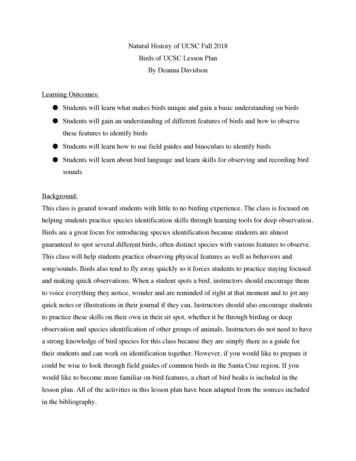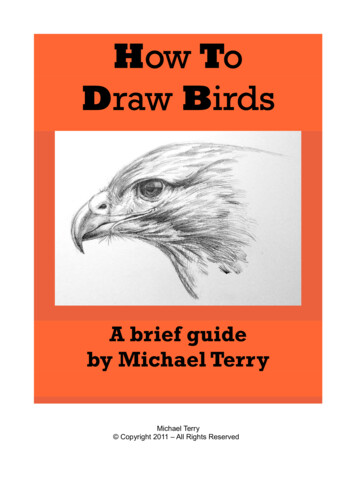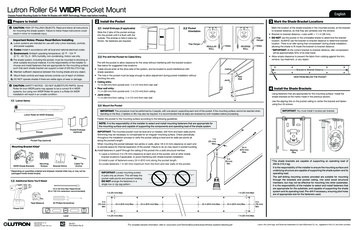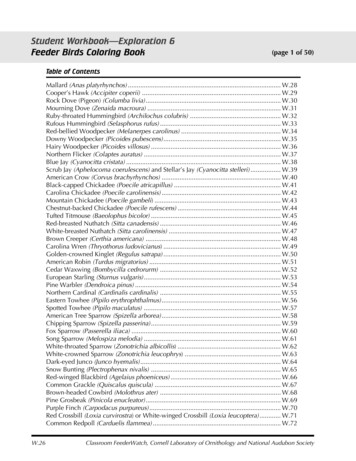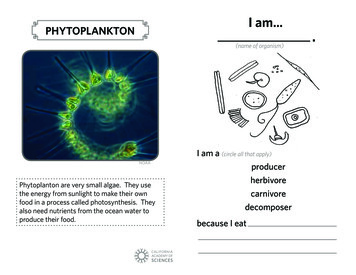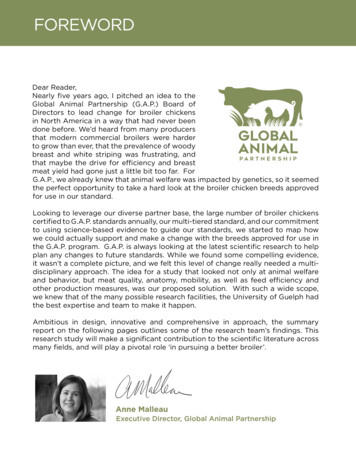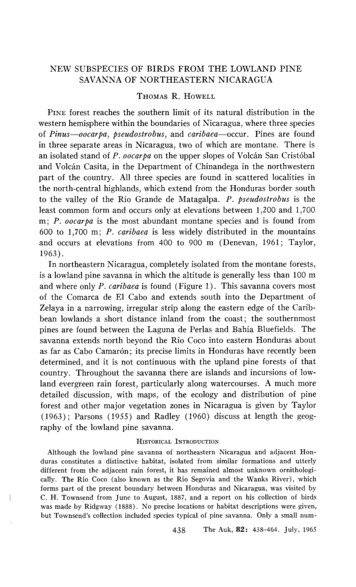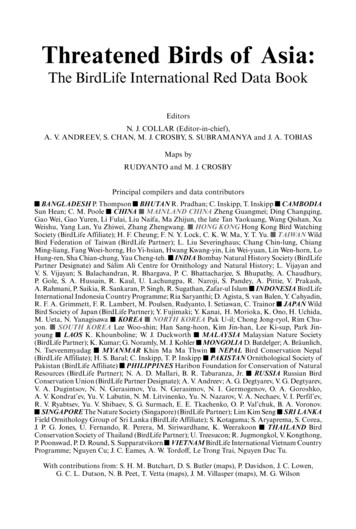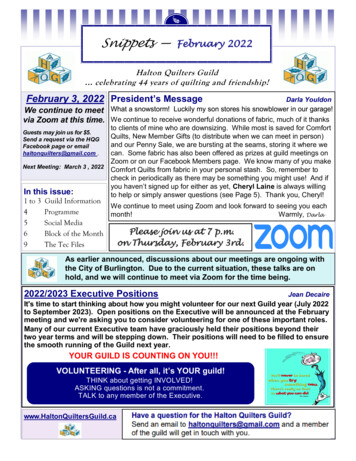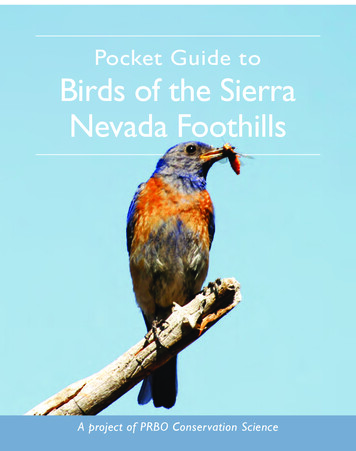
Transcription
Pocket Guide toBirds of the SierraNevada FoothillsA project of PRBO Conservation Science
Pocket Guide toBirds of theSierra Nevada FoothillsRenée Cormier and Ryan BurnettPRBO Conservation ScienceCalifornia Partners In FlightPRBO Conservation Science (PRBO) is dedicated toconserving birds, other wildlife, and ecosystems throughinnovative scientific research and effective outreach.California Partners In Flight (CalPIF) is a voluntarycoalition of state and federal agencies and privateconservation organizations dedicated to conserving birdpopulations and their habitats.Together, PRBO and CalPIF ensure that sound science ishelping to guide conservation efforts and habitat management. For more information on PRBO, visit wwww.prbo.org.For more information on CalPIF, visit www.prbo.org/calpif.
Contact UsHelp support PRBO’s mission to conserve birds and their ecosystems through research and outreach. You can join or make adonation online at www.prbo.org.To receive additional copies of this guide, please call PRBOConservation Science at (707) 781-2555 x 307. For moreinformation about PRBO’s projects throughout the West, visitwww.prbo.org.Give us your feedback at www.prbo.org/feedback.Copyright 2008 byPRBO Conservation Science3820 Cypress Drive #11Petaluma, CA 94954www.prbo.org
AcknowledgmentsThe pocket guide concept was developed by theRocky Mountain Bird Observatory (RMBO).Melissa Pitkin and Rich Stallcup providedcomments on various portions of this guide.Layout was completed by Claire Peaslee.Thanks to the following photographers for donating images:California Waterfowl Association, Lyann Comrack,James R. Gallagher – Sea and Sage Audubon,Tom Grey, Peter LaTourrette, Rick Lewis, StuartMacKay, Martin Meyers, Eric Preston, ChrisRintoul, Steve Smith, Rich Stallcup, Boris Tonico,and Wendy Willis. Illustrations by Zac Denning.Cover photos: Western Bluebird (front), NorthernFlicker (back), both by Martin Meyers.Production of this guide was funded by:A friend of the Sierras.
IntroductionThe foothills of the western slope of the SierraNevada Mountains (hereafter, Foothills) are comprised of diverse habitat types and bird species.Some of the more dominant habitats include: oakwoodland, oak-pine woodland, chaparral, andriparian. These habitats are all an integral part of thelandscape and support essential plant and animal life.While some of the bird species are strictly associatedwith a particular habitat type, others can be foundin almost all habitats. Here, we provide an introduction to the most common birds in the Foothills, andprovide suggestions for their conservation.How to Use this GuideThis guide was written for anyone interested inlearning about the most common bird species in theFoothills. We focus on 66 species, and separate themaccording to where they place their nests – differentbird species select different locations within a habitatto build their nests and raise young. Some speciesin the guide do not nest in the Foothills, but are in
cluded in the section where they are most commonlyfound. Within each section, species are listed in taxonomic order. Categories are divided as follows:1) Understory, shrub and ground nesters anddwellers2) Midstory nesters and dwellers,3) Canopy nesters and dwellers, and4) Cavity nesters and non-traditional nesters (suchas nests on cliffs, streamside banks, eaves, orother human-made structures).Use the photographs to identify the different birdspecies you see, and read about their habitat needs.Note the simple actions that you can take to makeyour land a better home for birds. Even smallchanges can make a big difference in birds’ lives!Species ProfilesEach species profile includes a photo. An attemptwas made to include photos of birds in plumagetypical of how they usually look while in theFoothills (some birds appear different depending on
their age, sex or on the time of the year).Each species profile includes the following:1) Identification: An overview of important physicalfeatures or behavioral clues that help identify aparticular species, including its length in inches.We note when males and females or different ageclasses look different.2) Timing: When the species occurs in the Foothills.Note: “Winter” is defined as birds that arrive inthe fall and stay until spring, but do not breed hereduring the summer months.3) Diet: Main food items.4) Conservation: Describes specific ways you canhelp to conserve birds and their habitats. Plantnames are listed in Latin (spp. species).This is not a comprehensive guide to birds of theFoothills, but an introduction to the species, theirhabitats and how to conserve them. References arelisted at the end of this guide.
Understory, Shrub, and GroundNesters and DwellersUnderstory and shrubby vegetation provides protection and food resources for a variety of bird species.A healthy understory (low-growing plants) is a critical component of healthy forest and shrub habitatsin the Foothills. While some birds require large contiguous blocks of dense shrubs, others require densepatches of shrubs interspersed with openings.Understory the underlying layer of vegetation.
Understory Habitat Improvement Tips Plant clumps of low-growing shrubs and forbsthat are native to your region. Some plantsprovide shelter and nesting substrate, while othersprovide berries, seeds, and nectar for a varietyof bird species. Although appropriate nativesfor your yard depend on your region and thehabitat where you live, some native understoryplants include: Artemisia spp., Ceanothus spp.,Cercis occidentalis, Epilobium californica,Fremontodendron californicum, Rhamnus crocea. Protect large areas of native chaparral andshrubland, and manage for a mix of dense and openareas. Do not mow during the nesting season, to avoiddestroying ground and low nests (March–August). Plant armored vegetation like buckbrush(Ceanothus cuneatus), to help protect nesting birdsfrom predators. Allow the understory to connect with the midstorystory, to help enhance habitat structure.
Rick LewisUnderstory, shrub, groundCalifornia Quail(Callipepla californica)Identification: 10 – Chunky with black plume onforehead. Gray-brown, scaled belly. Often in groups.Male (shown): White-bordered black face and throat.Female: Brown overall with shorter plumes.Timing: Year-round.Diet: Seeds, leaves.Conservation: Plant dense clumps of shrubs andtrees. Use native vegetation such as Rubus ursinus(California blackberry), Ceanothus shrubs, oaks, andnative grasses.10
Eric PrestonUnderstory, shrub, groundTurkey Vulture(Cathartes aura)Identification: 26 – Blackish-brown overall, unfeathered red head. In flight, underwings two-toned(light hindwing).Timing: Year-round.Diet: Carrion.Conservation: Maintain a mix of forested and openhabitat for foraging and retain large native trees inareas away from human activities for communalroost sites.11
Eric PrestonUnderstory, shrub, groundNorthern Harrier(Circus cyaneus)Identification: 18 – Long wings and tail. Whiterump patch in flight. Male: Upperparts gray. Female:Upperparts brown, underparts boldly streaked.Young: Like female, but rusty below.Timing: Year-round.Diet: Small mammals, reptiles.Conservation: Northern Harriers nest on theground in tall grassy areas and are sensitive todisturbance. Maintain unmowed open habitats thathave enough cover for prey species.12
Steve SmithUnderstory, shrub, groundGreater Roadrunner(Geococcyx californianus)Identification: 23 – Distinctive. Large and longtailed. Streaked overall, crest often raised.Timing: Year-round.Diet: Invertebrates, small reptiles, birds, eggs,carrion, plant material.Conservation: Protect habitat that has a mix ofopen habitat for foraging and dense shrub cover fornesting.13
Eric PrestonUnderstory, shrub, groundWrentit(Chamaea fasciata)Identification: 7 – Skulks through dense shrubs.Long tail often held askew to the body. Upperpartsbrown, underparts pinkish-brown.Timing: Year-round.Diet: Insects, spiders, fruit, seeds, other plant matter.Conservation: Maintain large areas with diverseand dense shrub cover and protect shrub corridorsthat connect habitat fragments.14
Martin MeyersUnderstory, shrub, groundCalifornia Thrasher(Toxostoma redivivum)Identification: 12 – Long down-curved bill. Longtail. Light brown upperparts, buffy underparts.Timing: Year-round.Diet: Insects, other arthropods, fruit.Conservation: California Thrashers are only foundin the foothills of California and coastal scrub ofCalifornia and Baja, Mexico. Preservation of denseand diverse shrub habitat is essential for this species.15
Peter LaTourretteUnderstory, shrub, groundYellow-breasted Chat(Icteria virens)Identification: 8 – White “spectacles” on face.Throat and chest yellow, belly white. Upperpartsgrayish olive.Timing: Summer.Diet: Insects, berries.Conservation: Wherever possible, widen creekside(riparian) vegetation corridors by planting clumpsof shrubs and trees. Use native vegetation such asSalix spp. (willows) and Rubus ursinus (Californiablackberry).16
Rick LewisUnderstory, shrub, groundSpotted Towhee(Pipilo maculatus)Identification: 9 – Male (shown): Head, chest, andupperparts black, sides rusty. Red eyes, white spotting on wing, long black tail. Female: Grayish brownwhere male is black.Timing: Year-round.Diet: Insects, seeds, berries.Conservation: Create travel corridors by connecting patches of vegetation along streamside (riparian)and maintain dense patches of shrubs.17
Tom GreyUnderstory, shrub, groundCalifornia Towhee(Pipilo crissalis)Identification: 9 – Uniformly grayish-brown withcinnamon undertail feathers. Long tail. Often seenforaging on the ground.Timing: Year-round.Diet: Seeds, some insects.Conservation: Plant native shrub species and protect chaparral and streamside (riparian) habitats.18
Martin MeyersUnderstory, shrub, groundRufous-crowned Sparrow(Aimophila ruficeps)Identification: 6 – Crown rusty, upperparts grayishbrown, often with rusty streaks. Gray “eyebrow.”Black and white mustache. Gray underparts.Timing: Year-round.Diet: Seeds, other plant material, insects.Conservation: Maintain dense shrub habitat interspersed with open rocky areas on your land.19
Martin MeyersUnderstory, shrub, groundBlack-chinned Sparrow(Spizella atrogularis)Identification: 6 – Gray head and underparts. Pinkbill. Brownish streaked back. Adult (shown): Blackpatch surrounding bill.Timing: Summer.Diet: Insects, seeds, grass, forbs.Conservation: Black-chinned Sparrows are relatively uncommon in the Foothills and of conservation interest. Preserve low-growing shrub habitat.20
Steve SmithUnderstory, shrub, groundLark Sparrow(Chondestes grammacus)Identification: 7 – Bold white, black, and chestnut(or brown on young birds) head pattern. White outertail feathers. Whitish breast with dark central spot.Timing: Year-round.Diet: Insects, seeds.Conservation: Maintain areas of open woodlandand grassland and avoid activities that disturb groundnests (Mar.–Aug.), such as mowing and off-trailrecreation.21
Peter LaTourretteUnderstory, shrub, ground(Bell’s) SageSparrow(Amphispiza belli)Identification: 6 – Dark gray head with bold whitemoustache. White breast with dark central spot.Often on ground with tail raised.Timing: Year-round.Diet: Insects, spiders, seeds, fruit, plant material.Conservation: Plant native shrubs and maintaindense shrub patches.22
Eric PrestonUnderstory, shrub, groundSong Sparrow(Melospiza melodia)Identification: 6 – Upperparts reddish brownwith dark streaking. Gray face with brown stripes.Underparts whitish with heavy streaking.Timing: Year-round.Diet: Insects, seeds.Conservation: Avoid brush clearing during thebreeding season (Mar.–Aug.), and maintain lush,dense streamside and wetland areas.23
Eric PrestonUnderstory, shrub, groundWhite-crowned Sparrow(Zonotrichia leucophrys)Identification: 7 – Streaky brown upperparts, plaingray underparts. Adult (shown): Black and whitecrown stripes. Young: Brown crown stripes.Timing: Winter.Diet: Seeds, buds, grass, fruits, arthropods.Conservation: After tree and shrub trimming inthe fall, leave brush piles and a mix of shrub andopen grassy areas, which provide cover and foraginghabitat.24
Rick LewisUnderstory, shrub, groundGolden-crowned Sparrow(Zonotrichia atricapilla)Identification: 7 – Yellow fore-crown surroundedby black or brown stripes (varies by age and time ofyear). Underparts grayish, streaky brownish upperparts.Timing: Winter.Diet: Seeds, fruit, buds, flowers, arthropods.Conservation: After tree and shrub trimming inthe fall, leave brush piles and a mix of shrub andopen grassy areas, which provide cover and foraginghabitat.25
Rick LewisUnderstory, shrub, groundDark-eyed (Oregon) Junco(Junco hyemalis)Identification: 6 – Head light brownish-gray toglossy black. Bill pink. White outer tail feathers.Pinkish-brown sides.Timing: Winter.Diet: Seeds, arthropods, fruit.Conservation: Maintain areas of open woodlandand grassland for foraging.26
Martin MeyersUnderstory, shrub, groundLazuli Bunting(Passerina amoena)Identification: 6 – Male (shown): Head andupperparts turquoise blue. Chest cinnamon,underparts white. Two white wingbars. Female:Upperparts grayish-brown, underparts paler. Twopale wingbars.Timing: Summer.Diet: Seeds, insects.Conservation: Plant and maintain a diverse mixof low-growing shrubs and herbaceous vegetation.27
Rich StallcupUnderstory, shrub, groundRed-winged Blackbird(Agelaius phoeniceus)Identification: 9 – Male (shown): Black overallwith a bright red patch on each shoulder. Female:Brown overall with dark streaking on underparts.Timing: Year-round.Diet: Insects, seeds.Conservation: Maintain native shrub habitatadjacent to creeks and dense wetland herbaceousvegetation, such as Typha spp. (cattails).28
Steve SmithUnderstory, shrub, groundWestern Meadowlark(Sturnella neglecta)Identification: 9.5 – Bright yellow underparts,black breast band. White outer tail feathers.Timing: Year-round.Diet: Seeds, insects.Conservation: Support projects that promotegrassland restoration and avoid ground disturbingactivities during the nesting season (Mar.–Aug.).29
Midstory Nesters and DwellersMost midstory nesters and dwellers in the Foothillscan be found in oak, oak-pine, and riparian habitats.The midstory grows in the shadows of tall trees, andprovides shade to understory plants. Many midstorynesters make open-cup nests and place them in tallshrubs or small trees where they are well concealedfrom predators.Midstory the section of vegetation in a forest with more thanone vertical layer.30
Midstory Habitat Improvement Tips Plant clumps of tall-growing shrubs and lowgrowing trees that are native to your region. Add native fruit-bearing plants to your plantingmix, such as Rhamnus crocea, R. californica,and Sambucus mexicana. Allow the midstory to connect with other forestlayers to enhance habitat structure. Trim vegetation during the non-nesting season(Sept.–Feb.), to avoid disturbance to nesting birds. Plant a diversity of native flowering plants suchas Epilobium californica and Cercis occidentalis,to attract hummingbirds and other pollinators toyour yard. Promote oak regeneration and health. Other native plants, such as Calycanthus occidentalis,Ceonothus spp., and Arctostaphylos spp. can helpcontribute to a healthy midstory layer. See nativeplants listed on page 9 for suggestions of speciesthat may promote a healthy midstory.31
Steve SmithMidstoryMourning Dove(Zenaida macroura)Identification: 12 – Pinkish brown overall. Blackspots on wings and single spot on each cheek. Longpointed tail, tail feathers tipped white.Timing: Year-round.Diet: Seeds.Conservation: Avoid mowing, clearing brush andpruning trees in the breeding season (Mar.–Aug.).32
Rick LewisMidstoryAnna’s Hummingbird(Calypte anna)Identification: 4 – Upperparts green, underpartsgrayish. Male (left): Iridescent rose-pink crown andthroat. Female (right): Throat with lines of spots or asmall patch of pink.Timing: Year-round.Diet: Nectar, insects.Conservation: Plant flowering plants native to yourregion, such as Epilobium californica and Cercisoccidentalis.33
Rich StallcupMidstoryWestern Scrub-jay(Aphelocoma californica)Identification: 12 – Head and upperparts blue withblackish mask bordered above by white. Underpartsgrayish.Timing: Year-round.Diet: Insects, acorns, other seeds, berries.Conservation: Avoid clearing brush and pruningtrees during the breeding season (Mar.–Aug.).34
Martin MeyersMidstoryBushtit(Psaltriparus minimus)Identification: 5 – Grayish overall, underpartspaler, long tail. Very active. Often seen in flocks.Male and Young (shown): Brown eyes. Female:Pale eyes.Timing: Year-round.Diet: Insects.Conservation: Wherever possible, widen creekside (riparian) corridors by planting clumps ofshrubs and trees. Maintain trees that stand abovethe other layers of vegetation.35
Tom GreyMidstoryBlue-gray Gnatcatcher(Polioptila caerulea)Identification: 5 – Small with long tail. Bluishgray upperparts. White eye ring and white outer tailfeathers.Timing: Summer.Diet: Insects, spiders.Conservation: Manage for a mix of dense shrubsinterspersed with open areas.36
Stuart MacKayMidstoryAmerican Robin(Turdus migratorius)Identification: 10 – Head and upperparts darkgray, head often blacker. Underparts rusty. Yellowbill.Timing: Year-round.Diet: Insects, berries, earthworms.Conservation: Create feeding habitat by planting fruit-bearing plants such as Rubus ursinus(California blackberry) and Rhamus californica(coffeeberry).37
Steve SmithMidstoryCedar Waxwing(Bombycilla cedrorum)Identification: 7 – Sleek. Brown head with crest.Black mask. Pale yellow belly. Gray tail with yellowband at tips. Inner wing feathers may have “waxy”red tips.Timing: Winter.Diet: Fruit, insects.Conservation: Avoid using pesticides on your land.Fruit sprayed with pesticides can poison birds thatconsume the berries.38
Martin MeyersMidstoryPhainopepla(Phainopepla nitens)Identification: 8 – Red eyes, spiky crest, whitewing patches in flight. Male (shown): Glossy black.Female: Gray overall.Timing: Year-round.Diet: Berries, insects.Conservation: Maintain shrubs and trees thatproduce small berries, including Phoradendronand Arceuthobium spp. (mistletoe) in oaks.39
Tom GreyMidstoryYellow-rumped Warbler(Dendroica coronata)Identification: 5.5 – Yellow rump and side patches.White outer tail feathers. Overall plumage rangesfrom brown to blue-gray. Throat yellow or white.Timing: Winter.Diet: Insects, fruit.Conservation: Promote vegetation structure byplanting a diversity of native plants in your yard.40
Steve SmithMidstoryBlack-throated Gray Warbler(Dendroica nigrescens)Identification: 5 – Gray upperparts, bold facepattern. Vertical black streaks on sides. Yellow aboveeye inconspicuous. White on outer tail feathers.Throat black or white – varies by age and sex.Timing: Summer.Diet: Insects.Conservation: Preserve oak trees. Quercuschrysolepis (canyon oak) and Q. wislizeni (interiorlive oak) are commonly used for nest sites.41
James R. Gallagher, Sea and Sage AudubonMidstoryBlack-headed Grosbeak(Pheucticus melanocephalus)Identification: 8 – Male (shown): Orange-brownwith black head. Wings black and white. Female:Upperparts brown, underparts streaked. Tan eyebrow.Timing: Summer.Diet: Insects, seeds, berries.Conservation: Plant dense clumps of shrubs andtrees. Use native vegetation such as willows andoaks.42
Stuart MacKayMidstoryHouse Finch(Carpodacus mexicanus)Identification: 6 – Upperparts gray-brown withfaint streaks. Underparts whitish with brown streaks.Male (shown): Head, chest, and rump red. Browncheek patch. Female: Plain brown face.Timing: Year-round.Diet: Seeds, berries.Conservation: Maintain native oak and streamside(riparian) habitats.43
Wendy WillisMidstoryLesser Goldfinch(Carduelis psaltria)Identification: 5 – Upperparts greenish, underpartsyellowish. Wings black with white patches. Male(shown): Crown black.Timing: Year-round.Diet: Seeds, insects.Conservation: Plant native seed-producing grassesand wildflowers and dense clumps of shrubs andtrees, such as willows and oaks.44
Martin MeyersMidstoryLawrence’s Goldfinch(Carduelis lawrencei)Identification: 5 – Male (shown): Black face.Upperparts gray. Yellow belly and wing bars.Female: Brownish gray upperparts and head.Yellow areas not as bright as male.Timing: Summer.Diet: Seeds, fruit.Conservation: Promote native grasses andwildflowers, especially fiddleneck (Amsinckiaspp.).45
Canopy Nesters and DwellersCanopy nesters build their nests near or at the topsof trees. The canopy layer is comprised of tall trees,such as blue oak (Quercus kelloggii and Q. douglasii) and gray pine (Pinus sabineana), that provideshade to the plants below. In the Foothills, many raptors nest in the canopy layer, but smaller birds suchas the Hutton’s Vireo can also be found nesting highin the treetops.Canopy the uppermost layer in a forest, formed by thecrowns of trees.46
Canopy Habitat Improvement Tips Plant trees that are native to your region. Localoaks (Quercus spp.) and pines (Pinus spp.) canhelp contribute to a healthy canopy layer. Conduct necessary tree work (e.g., felling orpruning) during the non-nesting season (Sept.–Feb.), to avoid negative impacts to nesting birds. Retain trees that stand above the other layers ofvegetation to promote structure. Plant a diversity of tree species. Planting avariety of oaks that have acorns at differenttimes of the year can help support species thatrely on acorns as food throughout the year. Allow the canopy to connect with other habitatlayers. Promote oak regeneration and health. Minimize pesticide and rodenticide use. Allowinsect- and rodent-eating birds to consume pestson your land. Prey that are free of poisons willkeep the birds healthy, too!47
Steve SmithCanopyCooper’s Hawk(Accipiter cooperii)Identification: 17 – Tail long, rounded, andbarred. Short, round wings. Adult (shown): Bluishgray upperparts, reddish bars on underparts. Young:Brown upperparts, brown streaked underparts.Timing: Year-round.Diet: Birds and mammals.Conservation: Maintain wide patches of riparianhabitat where songbird-prey species are relativelyabundant.48
Martin MeyersCanopyRed-shoulderedHawk(Buteo lineatus)Identification: 19 – Upperwings checkered blackand white. Head and upperparts gray, underpartsrusty. In flight: Pale crescent near wingtip. Blackand white bands on tail.Timing: Year-round.Diet: Small mammals, amphibians, reptiles.Conservation: Connect patches of creeksidevegetation by planting native trees.49
Tom GreyCanopyRed-tailed Hawk(Buteo jamaicensis)Identification: 19 – Highly variable in appearance.Adult (shown): Tail broad and rufous. Commonly haspale chest and dark band across belly. Young: Browntail finely barred black.Timing: Year-round.Diet: Mammals, birds, reptiles.Conservation: Avoid disturbance near nest sites.50
Martin MeyersCanopyGolden Eagle(Aquila chrysaetos)Identification: 30 – Large and dark. Outer wingsoften with white patches. Adult (shown): Base of tailgray. Young: Base of tail white.Timing: Year-round.Diet: Mammals, birds.Conservation: Support programs that help increaseawareness of human impacts on raptors.51
Peter LaTourretteCanopyBand-tailed Pigeon(Patagioenas fasciata)Identification: 15 – Gray overall. Tail gray at base,with light gray stripe at end. Yellow legs and bill.Adult (shown): White collar.Timing: Year-round.Diet: Seeds, fruit, pine nuts, acorns.Conservation: Retain or plant oaks and berryproducing plants, which are important food sources.52
California Waterfowl AssociationCanopyGreat Horned Owl(Bubo virginianus)Identification: 22 – Large, gray-brown owl withthick ear tufts (“horns”). Yellow eyes. Series of lowhoots heard at night.Timing: Year-round.Diet: Mammals, birds, reptiles, amphibians.Conservation: Avoid using rodenticides at yourhome or property. Owls can be poisoned by feedingon rodents that have consumed poisons.53
California Waterfowl AssociationCanopyWestern Kingbird(Tyrannus verticalis)Identification: 9 – Belly yellow, chest pale gray,tail black with white outer edges. Head gray withdarker mask, upperparts gray.Timing: Summer.Diet: Insects.Conservation: Preserve snags for perching.54
Martin MeyersCanopyHutton’s Vireo(Vireo huttoni)Identification: 5 – Stocky with drab olive upperparts, white wing bars, eye ring, thick blue-gray legs,thick bill. Compare Ruby-crowned Kinglet.Timing: Year-round.Diet: Insects, spiders.Conservation: Preserve oak and pine-oak foresthabitat.55
Boris TonicoCanopyCommon Raven(Corvus corax)Identification: 24 – All black with wedge-shapedtail. Thick bill. Deep croaking calls.Timing: Year-round.Diet: Arthropods, amphibians, reptiles, birds (adults,chicks, eggs), small mammals, carrion, grains, buds,berries.Conservation: Raven populations can have negative effects on other nesting birds. Do not supplement their diet, and keep food sources (e.g., compostpiles) covered to prevent a feeding station.56
Tom GreyCanopyRuby-crowned Kinglet(Regulus calendula)Identification: 4 – Drab olive upperparts, whitewing bars, eye ring, thin blackish legs, thin bill.Male: Concealed red patch on head. CompareHutton’s Vireo.Timing: Winter.Diet: Spiders, insects, fruit, seeds.Conservation: Preserve streamside (riparian) andoak woodland habitat.57
Tom GreyCanopyBullock’s Oriole(Icterus bullockii)Identification: 9 – Male (shown): Face and underparts orange with black eyeline and throat. Crownand back black, wings black and white. Female:Upperparts olive-gray, underparts yellow and gray.Two white wing bars.Timing: Summer.Diet: Insects, berries, nectar.Conservation: Maintain large native trees alongriver corridors, especially oaks and Populus spp.(cottonwoods).58
Cavity and Non-traditionalNestersCavity a hollow or hole in a tree.59
Stuart MacKayCavity & non-traditionalWood Duck(Aix sponsa)Identification: 19 Male (shown): Head and crestdark green with white stripes. Red eyes and bill,white throat extending to cheek. Upperparts blackish, maroon chest. Female: Brown overall with thickwhite, teardrop-shaped eyering.Timing: Year-round.Diet: Acorns, other seeds, invertebrates.Conservation: Retain large native trees and snagswith cavities near creeks and ponds.60
Lyann ComrackCavity & non-traditionalAmerican Kestrel(Falco sparverius)Identification: 9 – Small falcon with long pointedwings, long tail. Often seen perched on wires in openhabitat. Boldly patterned face. Rufous upperpartswith black bars. Male (shown): Blue-gray wings.Timing: Year-round.Diet: Mammals.Conservation: Retain dead standing trees (snags)as potential nest sites.61
Cavity & non-traditionalSteve SmithWesternScreech Owl(Megascops kennicottii)Identification: 8.5 – Small owl with “ear tufts.”Yellow eyes. Call an accelerating series of shorthoots.Timing: Year-round.Diet: Small animals, especially mammals.Conservation: Conserve streamside (riparian)habitat and retain snags and other native trees withold woodpecker cavities for nest sites.62
Peter LaTourretteCavity & non-traditionalNorthern PygmyOwl(Glaucidium gnoma)Identification: 7 – Small owl, no ear tufts, longtail. Call repeated single or double hoots.Timing: Year-round.Diet: Small birds, mammals, insects.Conservation: See conservation of woodpeckerspecies, as Northern Pygmy Owls depend on oldwoodpecker nests for their own nest sites.63
Martin MeyersCavity & non-traditionalWhite-throated Swift(Aeronautes saxatalis)Identification: 7 – Sleek with long, straight wings.Black overall with white throat, belly and rumppatches. Fast, agile flight.Timing: Year-round.Diet: Insects.Conservation: Postpone activities that woulddisturb nesting birds (Mar.–Aug.) and avoid widespread use of pesticides, especially aerial spraying.64
Rick LewisCavity & non-traditionalBelted Kingfisher(Megaceryle alcyon)Identification: 13 – Long, pointed bill; bushyhead. Upperparts blue-gray with white collar. Bluegray band across chest. Female (shown): Also hasrusty band across chest.Timing: Year-round.Diet: Small fish.Conservation: Protect areas with stream-burrows.Kingfishers dig burrows into the soft banks ofstreams and rivers for nesting. Remove concrete,rock and other barriers to bank burrows.65
Eric PrestonCavity & non-traditionalLewis’s Woodpecker(Melanerpes lewis)Identification: 11 – Green back, red belly and face.Appears black in flight.Timing: Year-round.Diet: Insects, acorns, other nuts, fruit.Conservation: Retain dead trees (snags) andpartially dead trees to increase potential nest sites.66
Tom GreyCavity & non-traditionalAcorn Woodpecker(Melanerpes formicivorus)Identification: 9 – Black with white wing patchesand rump. Red head, whitish face. Often in groups.Timing: Year-round.Diet: Insects, acorns, fruit, other plant material.Conservation: Protect all species of oaks on yourland. A mix of oaks that vary in timing of seedproduction will help maintain bird populations thatrequire acorns in their diets.67
Martin MeyersCavity & non-traditionalNuttall’s Woodpecker(Picoides nuttallii)Identification: 8 – Black and white with barredupperparts. Spotted belly. Male (shown): Red onback of head.Timing: Year-round.Diet: Insects.Conservation: Retain dead trees (snags) andpartially dead trees to increase potential nest sites.68
Martin MeyersCavity & non-traditionalNorthern (Red-shafted) Flicker(Colaptes auratus)Identification: 13 – Orange-red under-wings andtail. White rump. Black necklace. Male (shown):reddish mustache.Timing: Year-round.Diet: Insects (especially ants), fruits, seeds.Conservation: Retain dead trees (snags) andpartially dead trees to increase potential nest sites.69
Lyann ComrackCavity & non-traditionalBlack Phoebe(Sayornis nigricans)Identification: 7 – Black overall with white belly.Often dips tail while perc
Diet: Seeds, fruit, buds, flowers, arthropods. Conservation: After tree and shrub trimming in the fall, leave brush piles and a mix of shrub and open grassy areas, which provide cover and foraging habitat. Rick Lewis 25 Understory, shrub, ground
